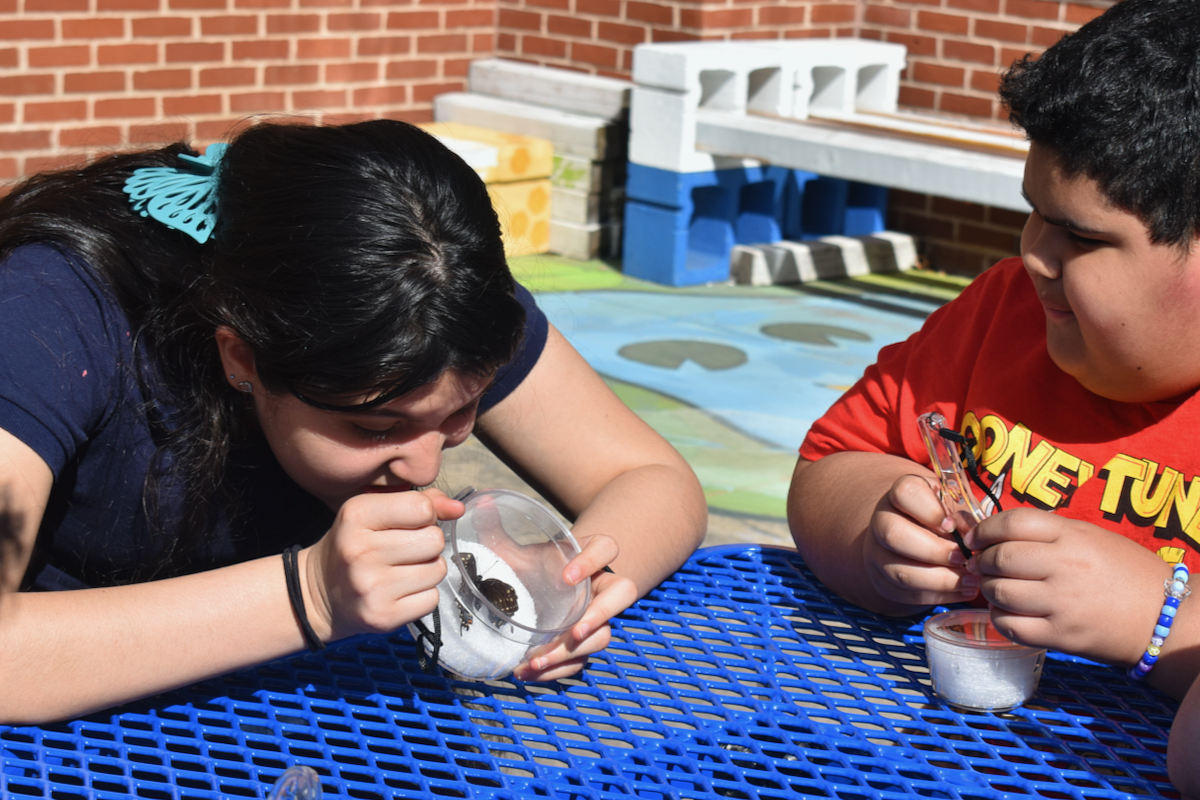
Maya McFadden
Ari checks out a preserved black swallowtail butterfly.
In the school’s garden space, Clinton Avenue School fifth-grader Ari brought a magnifier close to a green, rounded leaf plucked from a dandelion and discovered tiny pearls — better known as caterpillar eggs.
She did so as part of an outdoor lesson led by Common Ground’s Schoolyards Program educator Melissa Fredricksen.
The fifth-graders delved into a lesson (along with dirt) about butterflies and moths, their differences and life cycles on Thursday morning.

Fredricksen began the lesson by reading the students a book about metamorphosis.
“You will change while you are in your chrysalis. You will change a lot. You will grow six legs instead of sixteen. You will grow large eyes instead of small eyes,” Fredricksen read aloud from the book. “You will grow long feelers on your head. You will grow wings! When you have done all of these things, break out of your chrysalis.”
Students then recalled a past lesson with Fredricksen that taught them about what a butterfly tongue looks like. One student declared that it looks like a curly straw.
“Does anyone remember what the tongue of a butterfly is called?” Fredricksen asked.
The students thought back to the previous lesson while continuing to discuss the way the tongue works like a tube. “Proboscis,” one student called out — correctly, but slightly hesitant.

Fifth-graders inspect a preserved empty chrysalis by sniffing and shaking it.
After discussing the metamorphosis process, Fredricksen then showed the students her specimen collection of preserved butterflies and moths. This included a black swallowtail, monarchs, and painted lady butterflies, as well as luna and cecropia moths.
“Which one is more rare?” fifth-grader Jacob asked.
“They’re both very rare now,” Fredricksen said.
With magnifiers in hand, Fredricksen tasked the students with identifying differences between the butterflies and moths. They noted that the female luna moth was larger and plumper than the luna male, but that the male had a longer antenna.

Additional thoughts from the students included:
“It’s so fuzzy, it looks fake.”
“I think this butterfly used artificial colors.”
Fredricksen also informed the students that the moths have no mouths, that they each have short lifespans solely focused on reproducing, and that moths are nocturnal.
Then Fredricksen sent the students off to search for caterpillar eggs in the school garden beds. “Look under leaves, they’re gonna be tiny,” she said.


Fifth-grader Ari finds caterpillar eggs on the underside of a garden leaf and shows classmates.
As they searched, some students checked on the Marigolds they planted earlier in the program to decorate the back fence of the garden. They reminded Fredricksen and their peers that the plants will help to attract butterflies and bees to the garden.
Students wandered the garden using their magnifiers to get up close to the leaves of the plants in the garden beds. While butterfly eggs weren’t so easy to spot, the class had no trouble finding roly-polys and garden centipedes.
When fifth-grader Jacob found a centipede, he placed it gently in his hand and then ran over to his substitute teacher Michael Ferrett. Ferrett is a full-time building sub who has worked with the fifth grade class several times this year and was recently tasked with being a permanent sub for the class for 2 to 3 weeks.
“This is a great learning experience that allows for their curiosity to come out,” he said.
After each week’s Thursday lesson with Fredricksen, Ferrett said the students always return to class excited to update him on what they learned that day. “It’s an opportunity that opens their eyes and gives them the chance to participate in something new and find a new interest,” he added.

Substitute teacher Michael Ferrett checks out a garden centipede found by Jacob.
To conclude Thursday’s lesson the students were given pieces of Swiss chard growing in the school garden to taste.
Fredricksen works with K‑7 students at Clinton Ave each week. Her goal is to help students better “appreciate our natural world” by not fearing insects, but instead understanding their importance to our lives and gaining exposure to environmental and earth science.



Awesome lessons on science and nature! It sounds like so much fun. I wish we had lessons like this outside when I was a student.